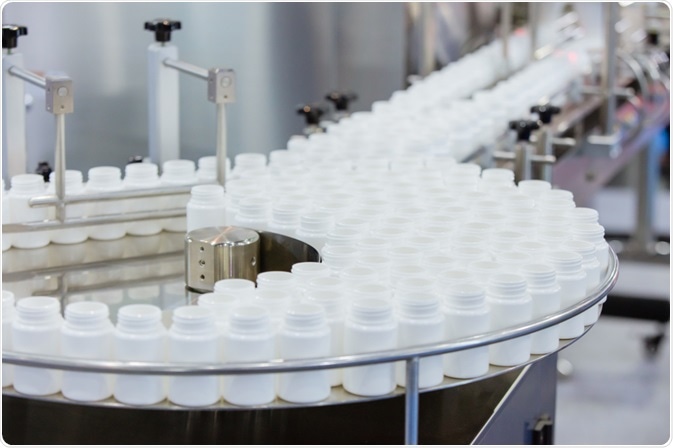Pharmaceutical packaging constitutes a small percentage of total generated waste, though is still of significant enough concern to warrant the world health organization (WHO) making various recommendations and nations enacting laws regarding the proper disposal of waste medical packaging.

Pharmaceutical Packaging. Image Credit: MOLPIX/Shutterstock.com
In the interest of sustainability, uncontaminated waste can be recycled depending on the availability of local facilities, with paper, plastics, glass, and metals often recycled directly. Contaminated waste, however, is usually incinerated, or otherwise taken to a landfill if incineration is not possible.
Other environmental concerns associated with the manufacture of a drug include the availability of active ingredients, many of which are sourced from plants, thus encouraging deforestation, the inclusion of toxic ingredients in the drug or packaging that then escape into the environment, and the use of chemicals that aid in the application of a drug, such as chlorofluorocarbons used in propellants.
Principles of sustainability
Sustainability is the ability to sustain something indefinitely, and in this context refers to the number of materials consumed by a process, and the ability to regenerate said materials in an environmentally friendly way.
The world health organization identified three directives to help reduce and eliminate waste: reducing packaging that is not essential to the protection of the drug, making as much of the packaging as possible recyclable, and making contaminated packaging incinerator-safe. For example, some plastics are more toxic than others when incinerated, while some plastics are significantly more toxic when undergoing incomplete combustion, highlighting the importance of disposal facility infrastructure development.
In 2005 the Sustainable Packaging Coalition defined sustainable packaging as safe for individuals throughout its life cycle, meets criteria for performance and cost, is manufactured and transported using renewable energy, uses recycled materials, uses materials that are friendly in likely end-of-life scenarios, and is physically designed to minimize materials and optimize energy use.
As many restrictions limit the use of recycled materials in pharmaceutical package production, manufacturers are encouraged to consider the recyclability of their product at the end of its life, making up for where laws do not allow for best sustainability. Additionally, the ability to sustainably source any packaging materials must be considered, as if demand is high even renewably sourced materials may not be sustainable.
Many pharmaceutical companies are achieving reduced packaging by lessening their weight. Modern plastics can be made thinner while maintaining strength, and advances in structural design thanks to computational engineering methods allow new designs that use far less material while maintaining the function and purpose of the packaging.
Competition between over-the-counter drug companies has led to an increase in the variety, size, and visual appeal of packaging, which may encourage the use of unnecessarily-sized and colored packaging. Regardless, packaging must maintain the information regarding contents, dosing, and safety precautions.
Another source of waste in pharmaceutical packaging is the use of accelerants and solvents that are damaging to the environment, for example, chlorofluorocarbons. Many pharmaceutical companies are researching and developing alternatives to these solvents, one example being Cyrene (di-hydro levoglucosenone), developed by Merck as an alternative to N-methyl-2-pyrrolidone or dimethylformamide. These chemicals are common intermediates in the pharmaceutical industry, used to enhance the absorption of topical drugs and as formulating agents, and can potentially pose an environmental hazard if allowed to accumulate.
The functionality of the product must always be the first priority when it comes to medicines, with some requiring high levels of moisture and light protection that necessitate sophisticated packaging. Insufficient packaging will inevitably, ultimately, generate more waste, as damaged goods must be disposed of and replaced.
Sustainability may also be implemented to a greater degree during manufacture. Large manufacturing runs of drugs are becoming less commonplace for new pharmaceuticals as generic manufacturers around the world begin to take over the production of off-patent drugs. Modern personalized medicine also forces smaller manufacturing runs that are inherently more wasteful, as down-time between producing batches is wasted time and energy that is spent setting up for the next run.
Companies are becoming increasingly streamlined and optimized in this regard, with, for example, the amount of heat applied to blister-packs being finely tuned-down to conserve energy, water consumption being closely monitored, and ventilation systems carefully optimized.
Tracking through the supply chain can also improve sustainability by optimizing the manufacturing rate and distribution of products, ensuring that it is not overproduced, minimizing energy-consuming storage time and that it is not transported more than is necessary.